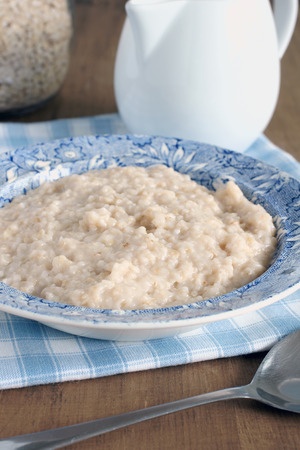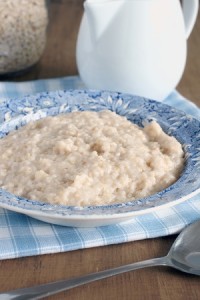 Soaked / Lightly Fermented is the best way to prepare grains.
Soaked / Lightly Fermented is the best way to prepare grains.
For digestibility, assimilation and nutritional benefit, grains (including breakfast porridge) should be soaked overnight or longer. With this method, the oats are set up to soak in acidified water for 8 – 24 hours. The setup is quick and easy to do after dinner or before bed.
Avoid over-reliance on starches and grains such as rice, corn, and oats. Eggs, fish, kefir, soups, cooked winter squash, and left-overs are more nutritious alternatives.
Oatmeal Porridge
- Combine in a thermos, small sauce pan, or covered bowl:
1 C organic rolled or cracked oats
1 C warm mineral water or filtered water
2 T whey (liquid drained from yogurt)
or 1 T lemon juice or rice vinegar
- Allow to sit at room temperature for 8 – 24 hours.
- 15 minutes before serving, boil:
1 C mineral water or filtered water combined with
½ tsp. mineral salt such as Real Salt® or Himalayan Pink Salt dissolved in it.
- Combine the soaked oats and the boiling salted water, let sit for 5 – 10 minutes.
Or, if you like you oats very squishy, heat and simmer for 3 minutes. Allow to sit for 5 minutes. - Serve with butter and cream or half-n-half.
- Additional toppings: stir in sprouted flax seeds, or sprinkle top with coconut flakes or sprouted pumpkin seeds.

I’m disappointed that you gave us a bad grain recipe. Surely you could have came up with something healthier.
I’m trying to be helpful to all kinds of dieters. I don’t recommend oats or eat them myself. But a lot of people do. Even though grain-free eating is a good and healthy choice, there are a huge number of people who are not ready for that step. I see myself as a “facilitator” not a “dictator”. The most important thing from my perspective is to give people easy strategies for improving the healthfulness of their foods, and to keep the bar low for starting low-oxalate eating.
The point of this recipe is that people who include grains in their diet need to know that it is important to soak them, and that’s what I want to illustrate here. Few people do that.
Thanks for your concern!
Sally
Thanks for this recipe Sally. I love oatmeal porridge but drastically reduced how often I ate it once I began a low oxalate diet. I have a different way of preparing mine though I don’t know if it is better at getting rid of some of the oxalates or not. I soak my oats overnight (and sometimes add a few pumpkin seeds and raisins) along with a bit of apple cider vinegar and water. Then in the morning I pour off all the water, rinse the oats, then add clean filtered water and cook it from that point, adding salt and coconut sugar, or whatever else I want. Would this be more or equally effective as your method at reducing some of the oxalates? I thought that cooking the porridge in some of the same liquid it soaked in was just keeping the oxalates in it, not destroying or reducing them. Thanks for the work you are doing!
By all means, discard the water from the first soak. But the most important reason to soak oats and other grains is to deal with phytic acid / phytates, another plant toxin that people who eat grains don’t pay any attention to (but they should). The long soak activates the sprouting process, which lowers phytates.
Although boiling greens such as broccoli and discarding the water can lower their soluble oxalate content, the soaking picture for oxalates is complex and depends on the food. I’m not aware of research on oxalate content of soaked/activated grains. Studies have indicated that soaking nuts may make the soluble oxalate content higher rather than lower (activation appears to transform insoluble to soluble oxalate).
But in the long run, I think you’re better off limiting grains in your diet.
This was really great information! I’m just looking into oxalate subject and looking back, I realize how I dodged the bullet while I was on a keto diet. I was over eating spinach, almonds and nuts in general and sure enough, I did not feel good. In fact, since I stopped eating spinach and much less nuts, my GI feels significantly better which indicates me a better health. I’m not a huge fan of oats since I’ve been on a low carb diet and understand the implications of grains, however it’s good to know how to go about it, when I feel like it on occasion. I think the key is, everything in moderation, rather then going cold turkey! Thank you for all your efforts for sharing your knowledge and rest assured, you’re greatly appreciated!
Its nice to hear a bit about your story. Its nice to know that you were listening to your body struggling on spinach and nuts and made a change for the better! I’m not a big fan of oats either, and would not use them as a daily staple. But, everyone needs to customize their diets and many need to keep a few options for occasional carbs when needed.
This is great My husband has had kidney stones but I didn’t know one needed to soak oatmeal overnight
I’m so sorry for your husband; kidney stones suck!
The reason for soaking oatmeal is not the oxalates, but rather to reduce other potentially toxic compounds such as phytates. The best approach to reducing oxalates is to avoid the highest oxalate foods and gradually move toward mostly eating low-oxalate foods. Boiling and soaking to reduce oxalate are only effective for certain foods that are already not too high in oxalates (e.g broccoli or asparagus). Oatmeal is not an especially high (or low) oxalate food. While it’s not on my “must avoid” list, I encourage you to consider other breakfast options (eggs are great if you can tolerate them; as are canned sardines if you can’t).
Are raisans high in oxalates?